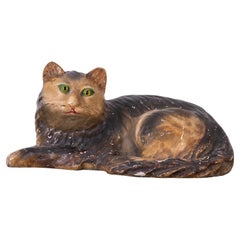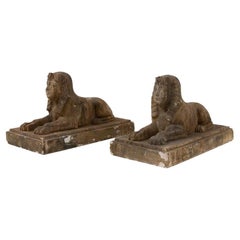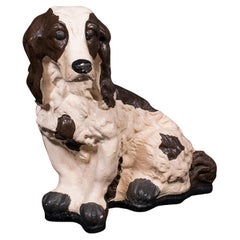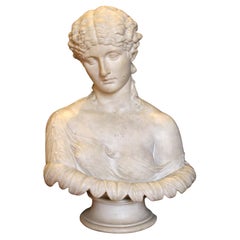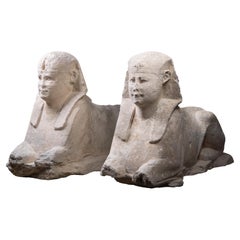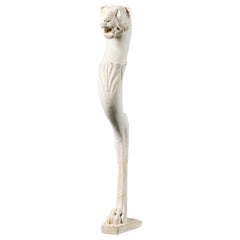Plaster Animal Sculptures
7
to
1
5
2
7
7
7
2
1
7
94
8
20
44
17
2
4
9
2
10
2
7
1
2
Height
to
Width
to
5,114
856
605
342
338
6
3
2
1
1
1
Period: 19th Century
Material: Plaster
19th Century Dominico Brucciani Plaster Study Bull El Museo Nacional del Prado
Located in Lowestoft, GB
A fine and early Dominico Brucciani plaster studies of a bull.
Very much in untouched original condition, with areas of loss mainly around the extre...
Category
Late 19th Century English Antique Plaster Animal Sculptures
Materials
Plaster
Pennsylvania Painted Chalkware Cat
Located in Savannah, GA
A Pennsylvania painted chalkware cat, circa second half 19th century.
These pieces usually painted by German-American folk artisans from Lancaster to Philadelphia were made to be a more accessible household ornament than expensive Staffordshire ceramics. They are more rare today due to their fragile gypsum composition. In the later part of the 19th century and into the 20th century these figures became popular as carnival prizes...
Category
Late 19th Century American Victorian Antique Plaster Animal Sculptures
Materials
Plaster
Chalkware Figure of a Seated Spaniel
Located in New York, NY
Charming figure of a spaniel cast from Staffordshire ceramic molds and handpainted in water-based pigments. Chalkware is made from plaster of Paris and was used to create inexpensive...
Category
Late 19th Century British Antique Plaster Animal Sculptures
Materials
Plaster
Pair of Egyptian sphinxes in gold-coloured scaiola plaster
Located in Milano, IT
Discover the epitome of elegance with this exquisite pair of Egyptian sphinx statues. Crafted with meticulous attention to detail, these magnificent sculptures are made of scaiola pl...
Category
1880s French Egyptian Antique Plaster Animal Sculptures
Materials
Plaster
Antique Cocker Spaniel Statue, English, Plasterwork, Dog Figure, Victorian, 1900
Located in Hele, Devon, GB
This is an antique cocker spaniel statue. An English, plasterwork dog figure, dating to the late Victorian period, circa 1900.
Fine decorative speci...
Category
Early 19th Century British Late Victorian Antique Plaster Animal Sculptures
Materials
Plaster
Antique Plaster Lion Head
Located in Alessandria, Piemonte
This antique plaster lion head has been reserved for years: now I'm publishing it for sale. I have no fountain, not even a garden that can welcome it. It'...
Category
Late 19th Century Italian Other Antique Plaster Animal Sculptures
Materials
Plaster
19th Century Polychrome Sculpture of a Roman Woman
Located in Haddonfield, NJ
Italian original painted plaster sculpture of a young Roman woman in nice gilt dress and flower wreath. This well sculptured smiling lady cou...
Category
1880s Italian Neoclassical Antique Plaster Animal Sculptures
Materials
Plaster
Related Items
Late 19th Century Plaster Faux Marble Bust
Located in Chapel Hill, NC
Plaster faux marble bust of Antonia, made by D. Brucciani & Co. London, late 19th century. A woman emerging from a calyx of leaf came to represent the nymph Clytie. A copy of the mar...
Category
Late 19th Century English Classical Roman Antique Plaster Animal Sculptures
Materials
Plaster
Ancient Egyptian Monumental Temple Sphinxes
Located in London, GB
A pair of monumental limestone sphinxes of Pharaoh Nectanebo I, from the processional avenue of the Serapeum of Memphis, 30th Dynasty, circa 379 - 360 BC.
The sphinxes of the Serapeum have captivated travellers since Roman times. However, despite their significance, they are conspicuously absent from the collections of most major museums. Indeed, their existence in private hands is so improbable, and their imitations so numerous, that the present sphinxes were assumed to be modern copies throughout their recent ownership history. Finally recognised and conserved after an extraordinary chance discovery at a garden furniture sale...
Category
15th Century and Earlier Egyptian Egyptian Antique Plaster Animal Sculptures
Materials
Limestone
Exceptional Egyptian Sarcophagus Mask
Located in London, GB
Exceptionally Fine Wooden Sarcophagus Mask
Third Intermediate Period, 21st Dynasty, circa 1069-945 BC.
Acacia wood, rosewood, hippopotamus ivory
Masterfully carved from a single piece of fine-grained hardwood, the present mask is characteristic of the most exquisite funerary art made during the 21st Dynasty, and was probably commissioned for a particularly high-ranking individual.
The oval face displays a gently smiling mouth with full, outlined lips, furrows at the corners and a bow-shaped philtrum. The straight nose with rounded nostrils, the cheeks full and fleshy and the large, almond shaped eyes with heavy lids and tapering cosmetic lines, set below long, sweeping eyebrows.
Social collapse across the Mediterranean in the Late Bronze Age meant that the 21st Dynasty in Egypt was a period of great turmoil. Trade routes were disrupted, governments collapsed, and mass migration occurred. Economic scarcity meant that traditional funerary practices in Egypt were also affected, with a lack of material and financial resources leading to the reuse of preexisting material. As a result, during the 21st Dynasty, 19th and 20th Dynasty coffins changed ownership rapidly and were heavily recycled for new purposes. Tombs were also unmarked allowing them to be shared
by many people. These new practices brought forth a shift in the understanding of funerary paraphernalia. No longer important objects owned forever by the deceased, they were now simply seen as short-term transformative devices, whose symbolic and ritualistic meaning could be appropriated for others. However, paradoxically, the art of coffin-making also reached new heights during this period, and many of the richly dec- orated “yellow” coffins, characteristic of the 21st Dynasty, are remarkable works of art in their own right. Indeed, knowing that coffins were being reused throughout Egypt, the Egyptian élite set themself apart by commissioning lavish sarcophagi decorated with the images and texts meant to help guide them to the afterlife, and which would otherwise have adorned the tomb walls. As coffins were the chief funerary element which now identified the dead and allowed them a physical presence in the world of the living, their quality and appearance were of the utmost importance.
The traditional coffin ensemble was made of three parts: a wooden mummy cover, which laid directly atop the mummy, an inner coffin, and an outer coffin, both made of a lid and case. Additional decorative elements, such as masks, were carved out separately and later glued or pegged to the lids. After the completion of the painted decoration, the sarcophagus was covered in a varnish to give it its yellow colour. Gilding was sometimes used for the coffins of the high priests’ families, notably on parts representing naked skin, such as the face mask. However, some of the élite tactically avoided gilding altogether as to ensure that their coffin would not be looted.
When manufacturing the inner and outer coffins, particular attention was paid to the woodwork. Displaying the skill of the carpenter, this type of funerary art has largely remained unparalleled throughout Egyptian history. The principal wood used to craft the present mask is Acacia nilotica. The evergreen Egyptian acacia was considered sacred and said to be the tree of life, the birthplace of the god Horus, as well as symbolic of Osiris, the god of the dead and resurrection. The modelling of the face in the wood is superb, but the inlays also help mark this mask out as exceptional. Inlaid eyes and eyebrows were extremely rare and reserved to the finest and most expensive coffins. Traditionally, eyes were made of calcite, obsidian, or quartz, and eyebrows of coloured glass paste or bronze. Here, the pupils, eyebrows, and cosmetic lines are inlaid with Dalbergia melanoxylon, a rare type of wood which belongs to the rosewood genus.
In antiquity, however, it was known as Ebony of the Pharaohs, from the Egyptian word “hbny”, meaning dark timber, because of its black, lustrous appearance. An extremely dense and hard wood requiring significant skill to work with, ebony was a luxury material highly coveted by the pharaohs themselves, to make furniture, decorative and funerary objects. The wood was imported with great effort from the southern Land of Punt, most likely modern Sudan, Ethiopia, Djibouti, and Eritrea, alongside other luxury goods such as gold and ivory.
A magnificent ebony throne, recovered in the tomb of King Tutankhamun, illustrates the incredible aesthetic potential of this material and why it was so highly valued by Egyptian royalty. Only élite members of Egyptian society could have afford- ed Ebony of the Pharaoh inlays for their funerary mask.
The sclerae on the present piece were once both inlaid with hippopotamus ivory. Whiter than elephant ivory, this type of ivory is also denser, and more difficult to carve. The use of this luxury material, reputed for its gleaming appearance, enhances the lifelikeness of the eyes. For the Egyptians, hippopotamus ivory was imbued with magic powers. The hippopotamus was indeed both feared and venerated due to its aggressive behaviour. Whilst the male hippopotamus was associated with danger and chaos, the female was benevolent and invoked for protection, especially of the house and
of mothers and their children, through the hippopotamus goddess Tawaret. Thus, not only was hippopotamus ivory used as an inlay and to make practical objects, such as combs and clappers, but it was also used to make talismans like apotropaic wands or knives.
Made during a time of scarcity where few could afford made-to-order coffins, the present mask could have only belonged to one of the highest-ranking individuals in society. Undoubtedly one of the finest Egyptian coffin...
Category
15th Century and Earlier Egyptian Egyptian Antique Plaster Animal Sculptures
Materials
Fruitwood, Hardwood
Two-Headed Egyptian Sphinx Sculpture
Located in Asheville, NC
This two-headed Egyptian sphinx is constructed of solid wood. The wood has been treated to take on a sandy, almost marble, finish. Unlike the Greek sph...
Category
20th Century Egyptian Plaster Animal Sculptures
Materials
Wood
Emile Galle Faience Painted Pottery Cats Pair
By Emile Gallé
Located in Dallas, TX
A pair of Emile Galle signed comical whimsical cats with glass eyes made in Nancy France
Circa 1890. Nancy France
Signed on legs with the Gallé Reinemer mark.
The pair of faience ye...
Category
1880s French Art Nouveau Antique Plaster Animal Sculptures
Materials
Pottery
Late 19th Century Bronze Sculpture of Bull
Located in Dublin 8, IE
Late 19th Century Bronze Sculpture of a Bull by the French sculptor, Isidore Jules Bonheur. Set on a naturalistic base and raised on a black marble plinth. Signed 'I. Bonheur' and fe...
Category
Late 19th Century French Antique Plaster Animal Sculptures
Materials
Marble, Bronze
Large Lion's Head Sculpture
Located in West Palm Beach, FL
Stately Lion's head wall mounted sculpture.
Category
20th Century Plaster Animal Sculptures
Materials
Composition
Early 20th Century English Staffordshire Spaniel Dog Figurines, Pair
Located in Doylestown, PA
Facing pair of Staffordshire spaniel figurines, England, c. 1920.
Charming hand-painted ceramic King Charles Cavalier Spaniels in black and white paint decoration with a gilt collar...
Category
1920s English Victorian Vintage Plaster Animal Sculptures
Materials
Ceramic, Paint
Vintage Pair of Egyptian Cream Recumbent Sphinxes 20th Century
Located in London, GB
This is a beautiful Vintage pair of French composite sculptures of Egyptian recumbent Sphinx, dating from the late 20th Century.
Each sphinx is modelled wearing a pharaonic headdre...
Category
Late 20th Century Plaster Animal Sculptures
Materials
Other
Japanese Hand Painted Ceramic Cat Sculpture
Located in Douglas Manor, NY
3-726 vintage Japanese hand painted ceramic cat sculpture
Category
1950s Japanese Vintage Plaster Animal Sculptures
Materials
Ceramic
Egyptian Head of a Man
Located in London, GB
Egyptian head of a man, carved granite. 18th Dynasty, circa 1550-1292 B.C.
Carved in beautiful dark granite, this head depicts an elite individual, perha...
Category
15th Century and Earlier Egyptian Egyptian Antique Plaster Animal Sculptures
Materials
Granite
Terracotta Lion's Head Wall Decoration, Attributed to The Ringling Bros., FL.
Located in Atlanta, GA
A terracotta lion head wall-mounted decoration. This vintage terracotta lion, attributed to have originated out of The Ringling Bros. and Barn...
Category
Mid-20th Century American Plaster Animal Sculptures
Materials
Terracotta
H 15 in W 17 in D 13.5 in
Previously Available Items
Regency Style Antique Plaster Monopodia Lion
Located in Wormelow, Herefordshire
An English Regency style antique plaster lion mask monopodia, circa 1850. Once a supporting bracket for furniture or architecture, this plaster lion’s ...
Category
Mid-19th Century English Regency Antique Plaster Animal Sculptures
Materials
Plaster
Wall Mounted Lion's Head
Located in West Hollywood, CA
19th-century plaster molded lion head mounted on an oak plaque. English, circa 1890.
Category
1890s English Antique Plaster Animal Sculptures
Materials
Plaster, Oak
French, Horse Club Horse Head Sculpture
Located in Austin, TX
Horse head sculpture, French, made of plaster. This striking sculpture is two pieces, the horse head and a base and can be separated for transit. The detail is striking. Originally f...
Category
19th Century French Antique Plaster Animal Sculptures
Materials
Plaster
19th C Italian Basilica, Venice St Marks Plaster Equestrian Horse Statuette
Located in Lowestoft, GB
A particularly pleasing and gracefully executed sculpture on a prancing horse, taken from the famous statues of St marks Basilica, Venice.
Late 19th century in age, Italian in ori...
Category
Late 19th Century Italian Antique Plaster Animal Sculptures
Materials
Plaster, Pine
H 24.81 in W 25.01 in D 9.26 in
Antique Plaster Plaque Depicting the Lamb of St. John on a Naturalistic base
Located in Wormelow, Herefordshire
From the Studio of Ralph & Rodger Hedley (1838-1913 * 1879-1970).
Category
19th Century Antique Plaster Animal Sculptures
Materials
Plaster
H 14.96 in W 18.5 in D 1.97 in
Borghese English Victorian Period Majolica Owl Figurine, Circa 1871
By Borghese
Located in Van Nuys, CA
Borghese English Victorian period Majolica owl figurine. Lable and #123 underneath.
Registry Date of November 9, 1871.
Perched on a log on a rocky gro...
Category
19th Century British Victorian Antique Plaster Animal Sculptures
Materials
Plaster, Resin
French Grotesque Medieval Plaster Releif of Monkey Architectural Fragment
Located in Lowestoft, GB
A rather striking plaster relief of a mysterious mythical monkey in the medieval style.
Open mouthed with a gaunt demeanour, of plaster and straw construction.
In good original...
Category
Mid-19th Century French Medieval Antique Plaster Animal Sculptures
Materials
Plaster
H 13.39 in W 14.57 in D 9.06 in
19th Century Stucco Sculpture of Two Dogs, Signed Albert Hager
Located in Esbeek, NL
19th century stucco statue of 2 dogs
original patina
signed A. Hager, belgian 1857-1940
Category
19th Century Belgian Antique Plaster Animal Sculptures
Materials
Stucco
Borghese English Victorian Period Majolica Owl Couple Figurine, Signed
By Borghese
Located in Van Nuys, CA
Borghese English Victorian period Majolica owl couple figurine. Registry date of November 9, 1871. Table two registry mark on the back. The nuzzling owls ...
Category
19th Century European Antique Plaster Animal Sculptures
Materials
Resin, Plaster
Plaster Ram Head Sculpture
Located in Houston, TX
This wonderful plaster ram head figure was found in Southern France. The piece has incredible intricate detailing and is complete with unbroken horns and ears on either side of the r...
Category
19th Century French Other Antique Plaster Animal Sculptures
Materials
Plaster
Napoleon's Horse Sculpture, France, 19th Century
Located in Paris, FR
Tall dimension, beautiful, elegant and expressive sculpture representing Napoleon's horse, made in patinated plaster with its marble base of 17 cm x 17 cm. Empire style, France 19th ...
Category
19th Century French Empire Antique Plaster Animal Sculptures
Materials
Marble
Early 20th Century Italian Plaster Dog Head Mounts
Located in London, GB
Early 20th century Italian plaster dog head mounts
We are proud to offer a rare and very unusual set of 3 early 20th century plaster dog head wall mounts....
Category
Early 19th Century British Folk Art Antique Plaster Animal Sculptures
Materials
Plaster
Recently Viewed
View AllMore Ways To Browse
Horse Pedestal
Black Forest Dog
Mid Century Foo Dogs
Goose Sculpture
Turquoise Dog
Partridge Vintage
Owl Sculpture Wall
Bronze Egg Sculpture
Les Clements
Bronze Elephant Signed
Huge Ceramic Sculpture
Wooden Tiger
Bronze Herons
Large Wooden Horses
Antique Bronze Animal Figures
The Wolf Sculptures
Wood Animal Statue
Porcelain Rooster

